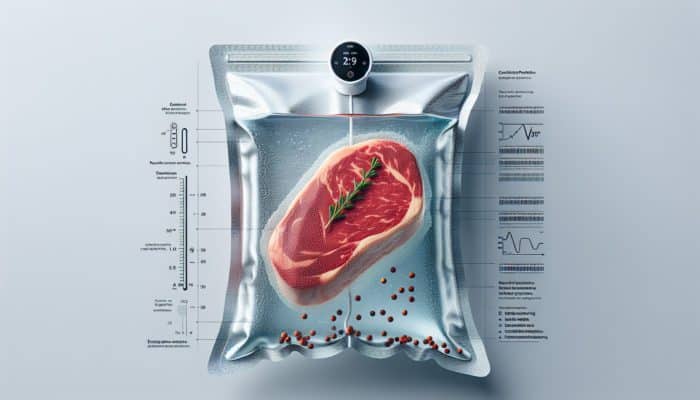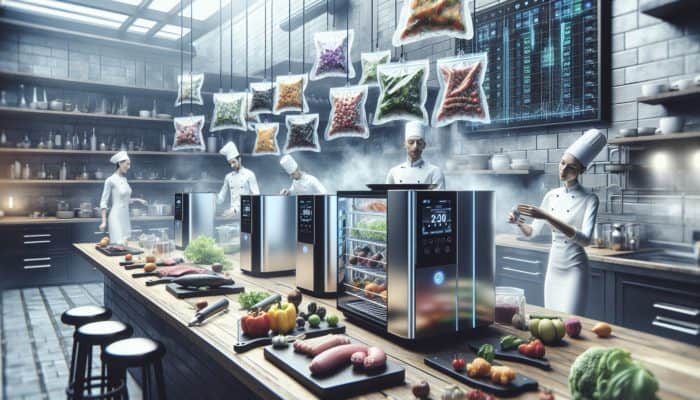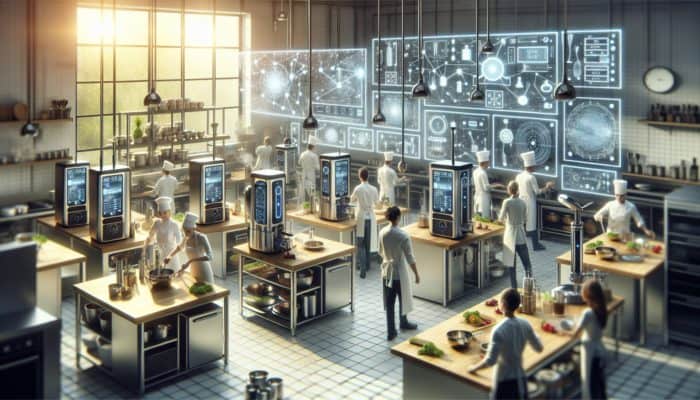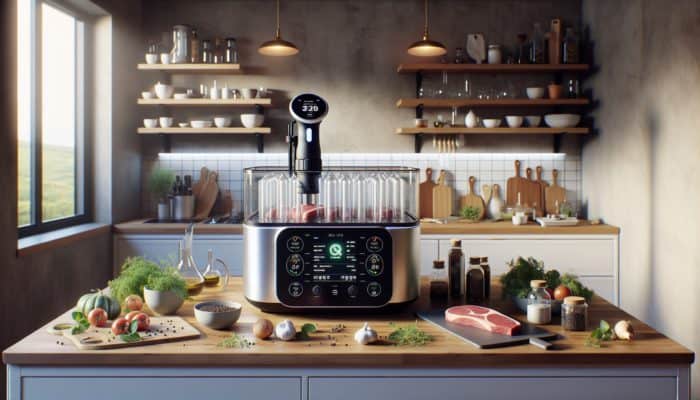Discover the Art of Sous Vide Cooking
What Is the Sous Vide Cooking Technique?

Top Sous Vide Trends for Modern Kitchens: Sous vide cooking is an innovative culinary method that involves vacuum-sealing food items in plastic pouches and immersing them in a precisely regulated water bath. This technique guarantees uniform cooking results, ensuring that heat is evenly distributed throughout the food. The gentle cooking environment preserves moisture, flavours, and essential nutrients, resulting in dishes that are not only tender but also bursting with rich taste. The precision provided by sous vide techniques allows chefs to achieve their desired textures without falling victim to common cooking errors, such as overcooking or uneven cooking.
The primary advantages of sous vide cooking comprise:
- Enhanced flavour preservation: Cooking food in its natural juices amplifies its flavours.
- Consistent results: Exact cooking parameters eliminate the uncertainties associated with traditional cooking methods.
- Improved texture: Low-temperature cooking ensures tenderness and prevents the food from becoming dry.
- Food safety: Cooking at controlled temperatures effectively eradicates harmful bacteria.
- Meal prep versatility: Sous vide allows for batch cooking, enhancing meal prep organisation.
- Easy experimentation: Home cooks can explore new flavour pairings and techniques.
What Is the Historical Background of Sous Vide Cooking?
The sous vide technique, translating to “under vacuum” in French, emerged in the late 1970s when French chefs began employing vacuum-sealed bags to cook food in water baths. Initially, this method was reserved for professional kitchens, aiming to achieve consistent culinary results and amplify flavours. Over time, advancements in technology have made sous vide equipment more accessible to home cooks, leading to its widespread popularity.
The introduction of affordable immersion circulators and vacuum sealers has transitioned sous vide cooking from a niche practice to a popular culinary trend. Innovations such as precise temperature controls, programmable timers, and smart device connectivity have enabled cooks to monitor and adjust their dishes remotely from anywhere. This accessibility has opened up new opportunities for both amateur and professional chefs, enabling them to delve deeper into flavour and texture exploration like never before.
What Basic Equipment Is Essential for Sous Vide Cooking?
To embark on your journey into sous vide cooking, a few essential pieces of equipment are indispensable. The cornerstone of this process is a precision cooker, which maintains a consistent water temperature throughout the cooking process. These devices come in various forms, including immersion circulators that can be clipped onto any pot or standalone sous vide machines specifically designed for the task.
A vacuum sealer is another vital tool, enabling cooks to remove air from bags containing food, thus enhancing heat transfer during the cooking process. Alongside this, vacuum bags or reusable silicone bags specifically designed for sous vide will ensure that food items retain optimal flavour and texture. Although the initial investment may seem daunting, the potential for culinary exploration and the ability to create restaurant-quality dishes at home make sous vide an enticing endeavour.
Stay Ahead of the Curve: Top Sous Vide Trends for Modern Kitchens

What Are the Latest Innovations Transforming Sous Vide Technology?
The sous vide landscape is constantly evolving, with groundbreaking innovations continually enhancing the cooking experience. Recent advancements include smart sous vide machines that feature Wi-Fi connectivity, enabling users to monitor and control cooking processes remotely via smartphone apps. This technology empowers chefs to adjust temperatures and cooking times on the fly, delivering a level of convenience previously unattainable.
Real-world applications of these innovations can be observed in bustling restaurant kitchens, where chefs utilise smart sous vide devices to manage multiple dishes simultaneously without constant supervision. These devices not only enhance cooking efficiency but also help maintain consistency across meals—a critical aspect of contemporary culinary practices. Furthermore, some sous vide machines now incorporate additional features, such as Bluetooth integration, voice control compatibility, and recipe recommendations tailored to user preferences, further solidifying their role as an integral component of the modern kitchen.
How Can Chefs Harness the Latest Sous Vide Trends?
Chefs can leverage current sous vide trends to transform their culinary practices. The precision and consistency offered by sous vide cooking empower chefs to produce dishes that consistently meet high standards, significantly reducing the risk of undercooked or overcooked meals. This level of control is especially advantageous for establishments focused on quality assurance, such as fine dining restaurants.
To effectively adopt these trends, chefs should consider integrating sous vide techniques into their existing menus. They might start by offering sous vide dishes as specials, allowing them to experiment with different proteins and flavour combinations. Additionally, chefs can utilise sous vide to minimise ingredient waste; by cooking in smaller batches tailored to demand, they can prevent surplus food from going unused. By continually refining their sous vide methods, chefs can stay ahead of the competition while delighting diners with innovative and consistently prepared dishes.
What Are the Future Predictions for Sous Vide Cooking?

Experts foresee a promising future for sous vide cooking, as its popularity continues to surge in both home and professional kitchens. With an increasing demand for precision in cooking and a desire for innovative culinary experiences, sous vide is set to become a staple in modern kitchens worldwide. Future developments may include even more interconnected smart technology that communicates seamlessly with kitchen appliances, further streamlining the cooking process.
Moreover, the exploration of new culinary applications for sous vide is expected to broaden its scope. From crafting unique marinades to developing entirely new dishes that highlight the versatility of the method, both chefs and home cooks will discover endless opportunities for creativity. As sustainability becomes an increasingly pressing concern, the capability of sous vide to reduce waste and energy consumption may also play a crucial role in its adoption. Overall, the future of sous vide cooking is poised for growth, with potential impacts on culinary arts that are both exciting and transformative.
How Does Sous Vide Cooking Elevate Flavour and Texture?
What Are the Key Flavour Enhancements Offered by Sous Vide Cooking?
One of the most notable advantages of sous vide cooking is its remarkable ability to lock in flavours. By cooking food in vacuum-sealed bags, the technique allows ingredients to simmer in their own juices, intensifying natural flavours and crafting delectable taste profiles. The precise temperature control inherent in sous vide means that food can be seasoned or marinated to perfection before sealing, allowing for deeper flavour penetration.
This method is particularly effective for proteins, as it prevents the moisture loss that often occurs with traditional cooking techniques. Consequently, sous vide dishes frequently surprise diners with their richness and complexity. Additionally, the ability to fine-tune cooking temperatures permits cooks to explore unique techniques, such as infusing flavours into oils or broths during the cooking process, further enhancing the culinary experience. By preserving moisture and locking in flavour, sous vide elevates even the most basic ingredients into extraordinary dishes.
How Does Sous Vide Cooking Affect Texture?
Sous vide cooking excels at maintaining the ideal texture of food, primarily through its low-temperature cooking method over extended periods. By immersing ingredients in a water bath at meticulously controlled temperatures, sous vide prevents the drying and toughening that can occur with higher heat methods. This results in perfectly tender meat and vegetables that retain their crispness without becoming mushy.
The technology behind sous vide also enables consistency that is often challenging to achieve through traditional cooking methods. For example, using sous vide, a steak can be cooked to a precise level of doneness throughout—eliminating the problem of overcooked edges with a rare centre. This control over texture also applies to vegetables, ensuring they are cooked to the desired firmness while preserving their vibrant colours and nutrients. By mastering the sous vide technique, cooks can create a variety of textures that delight the palate, making each dining experience truly memorable.
Techniques for Achieving Optimal Texture with Sous Vide Cooking
Achieving the perfect texture in sous vide cooking is an exhilarating journey of exploration and experimentation. The foundation lies in selecting the appropriate temperature and cooking time tailored to specific ingredients. For instance, a beef steak may be cooked at 55°C for a tender, medium-rare outcome, while vegetables like carrots might thrive at slightly elevated temperatures for optimal crispness.
Another technique to consider is post-sous vide searing. Following the sous vide process, quickly searing the protein in a hot pan can create a caramelised crust that enhances both flavour and texture. This additional step not only contributes to visual appeal but also introduces a delightful contrast to the tender interior.
To summarise, here are essential techniques to achieve optimal texture:
- Research ideal temperatures: Understand the best cooking temperatures for various proteins and vegetables.
- Control cooking time: Adjust cooking durations to achieve perfect tenderness.
- Post-cook searing: Enhance flavour and texture with a quick sear after sous vide.
- Experiment with infusion: Incorporate herbs and spices during the sous vide process for complex flavour profiles.
Mastering these techniques enables chefs to create stunning dishes that harness the incredible potential of sous vide cooking, resulting in a dining experience that is both captivating and unforgettable.
How Can Sous Vide Cooking Enhance the Flavours of Different Ingredients?
Sous vide cooking offers a unique capability to enhance the flavours of various ingredients through precise control over the cooking environment. This technique allows for the deep infusion of flavours, as the vacuum-sealed bags effectively trap aromas and essences. For example, marinating meats before sous vide cooking ensures that seasonings penetrate the surface, infusing the protein with robust flavours throughout the cooking process.
Vegetables also significantly benefit from sous vide cooking. By cooking them at lower temperatures, sous vide preserves their natural sugars and essential oils, resulting in a sweeter and more vibrant taste. This method also facilitates fun experimentation with diverse combinations of herbs and spices, as the sous vide technique enhances the overall flavour profile of each ingredient.
In essence, whether it’s meats, vegetables, or sauces, sous vide cooking unlocks the potential to create profoundly flavourful dishes by allowing chefs to control every aspect of the cooking process. The ability to maintain precise conditions leads to enhanced taste, transforming ordinary ingredients into extraordinary culinary experiences.
Exciting Sous Vide Recipes for Home Cooks
What Are Some Simple Sous Vide Recipes for Beginners?
For those new to sous vide cooking, starting with straightforward recipes can be both enjoyable and rewarding. Dishes such as sous vide chicken breast and salmon are excellent choices, as they require minimal ingredients and are forgiving in terms of cooking time. Additionally, these recipes illustrate the fundamental principles of sous vide cooking while delivering impressive results.
A basic sous vide chicken breast recipe involves seasoning the chicken with salt, sealing it in a pouch, and cooking it at 65°C for 1 to 2 hours. The result is a perfectly cooked, juicy chicken that pairs well with various sides or can be easily incorporated into salads. Similarly, sous vide salmon can be prepared by seasoning the fillets with lemon and dill, sealing them in vacuum bags, and cooking at 50°C for approximately 45 minutes. The outcome is tender, flaky salmon that retains its delicate flavours.
These approachable recipes serve as a stepping stone for beginners, providing them with the confidence to dive into more complex sous vide dishes as they refine their skills and develop their palates.
How to Prepare Sous Vide Steak at Home
Preparing sous vide steak at home is a straightforward process that guarantees a tender, juicy result every time. The magic lies in the precision of sous vide cooking, which enables meticulous temperature control throughout the entire cooking process. To prepare sous vide steak, follow these essential steps:
1. Season the steak: Generously season your steak with salt and pepper, or any preferred seasoning.
2. Seal the steak: Place the seasoned steak in a vacuum bag, ensuring it’s sealed properly to prevent water from entering.
3. Set the sous vide cooker: Preheat the sous vide water bath to your desired temperature, such as 55°C for medium-rare.
4. Cook the steak: Immerse the sealed steak in the water bath and let it cook for 1 to 3 hours, depending on the thickness of the cut.
5. Sear for finish: After cooking, remove the steak from the bag, pat it dry, and quickly sear it in a hot skillet for about 1-2 minutes per side to achieve a caramelised crust.
6. Serve and enjoy: Slice the steak against the grain and serve it with your favourite sides.
By following these steps, home cooks can enjoy a restaurant-quality steak prepared in the comfort of their own kitchen, showcasing the perfection that sous vide cooking brings to this beloved dish.
Creative Sous Vide Desserts to Experiment With
Sous vide cooking isn't limited to savoury dishes; it also opens up a world of possibilities in dessert making. The capability to maintain precise temperatures allows for the creation of unique textures and flavours in sweet treats, making sous vide a revolutionary tool in the dessert realm.
One delightful dessert to try is sous vide crème brûlée. The custard can be cooked at 82°C for 1 hour, resulting in a silky-smooth texture that serves as the perfect base for a caramelised sugar topping. Similarly, sous vide fruit compotes can be made by cooking fruits like berries and apples in sugar and spices at low temperatures, allowing the flavours to meld beautifully while maintaining the fruits' integrity.
These innovative desserts not only impress with their flavours but also showcase the versatility of sous vide cooking in creating stunning dishes that elevate the traditional dessert experience. Home cooks eager to explore new culinary horizons will find that sous vide desserts provide ample opportunities for creativity and experimentation.
Proven Strategies for Embracing Sous Vide Trends in Modern Kitchens
What Are the Best Safety Practices for Sous Vide Cooking?
When it comes to sous vide cooking, safety is paramount to ensure delightful results while preventing foodborne illnesses. Following best practices in food handling, vacuum sealing, and temperature control is essential. To maintain safety, food should always be cooked at temperatures that eliminate harmful bacteria without compromising quality.
For instance, cooking meats at 60°C for a minimum of one hour effectively destroys pathogens while retaining moisture. Additionally, vacuum sealing ensures that food is safeguarded during the cooking process, minimising the risk of cross-contamination. It’s crucial to maintain the sous vide water bath at the correct temperature and monitor it regularly.
Successful safety protocols can be observed in restaurants that utilise sous vide for meal prep while adhering to strict temperature controls and time limits. By prioritising safety in sous vide cooking, home cooks can produce meals that are not only delicious but also safe to enjoy.
How to Incorporate Sous Vide into Your Kitchen Workflow?
Integrating sous vide into your kitchen workflow requires thoughtful planning and organisation. The key is to view sous vide as a tool that complements existing cooking methods rather than a standalone technique. By incorporating sous vide into your routine, you can streamline meal prep and enhance efficiency.
Start by designating specific days for batch cooking using a sous vide method. Prepare several proteins or vegetables simultaneously, vacuum-seal them, and store them in the refrigerator for later use. This approach saves time during busy weeknights and ensures that healthy, delicious meals are readily available.
Additionally, consider utilising sous vide during sous-chef tasks or when preparing mise en place for larger meals. By integrating sous vide into your kitchen workflow, you can create a more seamless cooking experience, allowing for greater creativity and enjoyment in the kitchen.
What Cost-Effective Strategies Can Help You Start Sous Vide Cooking?
Embarking on a sous vide journey doesn't have to strain your budget. Implementing cost-effective strategies can make this innovative cooking technique accessible to many home cooks. First and foremost, invest in a reliable immersion circulator, as these devices offer excellent value for performance. Many budget-friendly options provide the necessary precision without sacrificing quality.
Utilising household items for vacuum sealing can also save money. For instance, heavy-duty resealable bags can be a useful alternative, allowing cooks to experiment before committing to more expensive equipment. Additionally, consider investing in silicone bags for sous vide, as they are reusable and environmentally friendly.
As confidence grows, upgrading to more advanced equipment can be done gradually. Many cooks begin with basic setups and progressively acquire additional tools, such as a vacuum sealer, to enhance their sous vide experience. This thoughtful approach to starting sous vide cooking makes it a feasible and enjoyable venture for home cooks everywhere.
What Are the Environmental Impacts of Sous Vide Cooking?
How Does Sous Vide Cooking Influence Energy Consumption?
Sous vide cooking is recognised for its energy efficiency, especially in comparison to traditional cooking methods. The technique generally involves cooking at lower temperatures over extended periods, resulting in reduced energy expenditure. By maintaining a constant temperature in a water bath, sous vide can consume less energy than conventional ovens or stovetops, where higher heat settings can lead to significant energy usage.
This efficiency becomes particularly apparent when cooking larger quantities or multiple dishes simultaneously. As sous vide equipment continues to evolve, newer models are designed to maximise energy savings while delivering outstanding culinary results. Both chefs and home cooks can benefit from this sustainable cooking method while being mindful of their energy usage.
What Are the Waste Reduction Benefits Associated with Sous Vide?
Sous vide cooking actively contributes to waste reduction by allowing for precise control during the cooking process. This technique reduces the risk of overcooking and spoilage, resulting in less food waste overall. With its ability to maintain optimal cooking conditions, sous vide helps ensure that ingredients retain their quality and freshness, resulting in less food being discarded.
Additionally, the use of vacuum sealing extends shelf life by reducing exposure to oxygen and slowing down the degradation of food. Leftovers or batch-cooked meals can be stored efficiently, providing opportunities for repurposing within recipes and further reducing waste. By incorporating sous vide cooking methods, home cooks and chefs can foster a more sustainable kitchen environment.
How Can Sous Vide Cooking Contribute to Sustainable Practices?
Sous vide cooking aligns with sustainable practices by promoting mindful cooking and minimising waste. The energy efficiency associated with the technique not only benefits home cooks' energy bills but also reduces the overall carbon footprint of food preparation.
Moreover, sous vide encourages the use of local and seasonal ingredients, as cooks can experiment with various fresh produce without concerns about spoilage. This approach supports local economies and reduces the environmental impact associated with long-distance food transportation. By embracing sous vide cooking, chefs and home cooks can contribute to a more sustainable food system while enjoying the culinary benefits of this innovative technique.
What Impact Does Sous Vide Cooking Have on Water Usage?
Sous vide cooking involves immersing food in water, which raises concerns about water consumption. While traditional cooking methods may require more water for boiling and steaming, sous vide typically utilises a smaller amount of water in a contained system. However, it’s essential to note that efficient water circulation systems can help mitigate the overall water impact.
Using containers that are appropriately sized for the amount of food being prepared can also help minimise water usage. Additionally, cooks can reuse water from previous sous vide sessions for cooking other dishes, ensuring a balanced approach to water conservation. By being mindful of water usage, sous vide enthusiasts can reap the benefits of this cooking method while being responsible stewards of the environment.
How Does Sous Vide Packaging Affect Environmental Sustainability?
The packaging used for sous vide cooking raises environmental concerns, particularly regarding the use of single-use plastics. The widespread use of vacuum-sealed plastic bags contributes to plastic waste, raising questions about sustainability. However, some alternatives can help reduce the environmental footprint associated with sous vide cooking.
Opting for reusable silicone bags is one effective strategy. These bags can withstand high temperatures and are designed for multiple uses, significantly decreasing reliance on single-use plastics. Additionally, biodegradable vacuum bags are emerging in the market, providing another option for environmentally conscious cooks. By exploring sustainable packaging options, sous vide enthusiasts can enjoy the culinary advantages of this method while making responsible choices for the planet.
Advanced Sous Vide Techniques for Professional Chefs
What Are the Cutting-Edge Sous Vide Cooking Methods?
Advanced sous vide techniques provide professional chefs with the opportunity to push culinary boundaries and explore innovative flavours and textures. Methods such as sous vide poaching, where delicate proteins or fruits are gently cooked in a precisely controlled water bath, allow for heightened flavour development without the risk of overcooking. This technique is particularly beneficial for dishes requiring finesse, such as poached eggs or seafood.
Sous vide confit is another advanced method that involves cooking foods, typically meats, in their own fat at low temperatures. This technique not only preserves the meat but also infuses it with rich flavours. Additionally, sous vide spherification allows chefs to create innovative dishes featuring liquid-filled spheres, an exciting presentation technique that captivates diners. By mastering these advanced methods, professional chefs can elevate their menus and offer guests unforgettable dining experiences.
How to Use Sous Vide in Molecular Gastronomy?
Molecular gastronomy embraces science and innovative techniques to create extraordinary culinary experiences, and sous vide serves as a foundational tool in this realm. Chefs can utilise sous vide to achieve precise temperature control, allowing for the transformation of ingredients in new and exciting ways. Techniques like sous vide gels and foams showcase the versatility of this cooking style.
For instance, sous vide gels can be created by cooking liquids infused with gelling agents at specific temperatures, resulting in textures that surprise and delight diners. Similarly, sous vide foams can be produced by emulsifying ingredients and cooking them under controlled conditions to achieve airy, flavourful toppings for dishes. By incorporating sous vide into molecular gastronomy, chefs can explore uncharted territories in flavour and presentation, captivating their audience with extraordinary culinary creations.
How Is Sous Vide Innovatively Applied in Fine Dining?
In the fine dining sector, sous vide has become synonymous with innovation and creativity. Chefs harness this technique to craft dishes that highlight unique textures and intricate flavours. For example, sous vide can be employed to prepare multi-component dishes that require precision and timing, ensuring that each element harmonises beautifully.
Innovative applications of sous vide in fine dining may include dishes where proteins are paired with seasonal vegetables, all cooked simultaneously at optimal temperatures. Chefs can use sous vide to create intricate flavour pairings, such as sous vide duck breast served with a seasonal berry compote, where both components are prepared with exacting standards.
Ultimately, the use of sous vide in fine dining not only elevates the dining experience but also showcases the chef's creativity and skill, allowing for culinary masterpieces that engage all the senses. The precision and control offered by sous vide make it an essential technique in the repertoire of chefs seeking to push the boundaries of contemporary cuisine.
Frequently Asked Questions
What temperature should I set for sous vide cooking?
The optimal temperature for sous vide cooking varies depending on the food item. For meats, a range of 55-60°C is common for medium-rare, while vegetables typically range from 85-90°C for the best texture.
How long can I cook food using a sous vide method?
Sous vide cooking times can vary widely. For tender proteins, cooking times of 1 to 4 hours are standard, while tougher cuts may benefit from longer cooking durations, sometimes extending up to 48 hours for maximum tenderness.
Is sous vide safe for cooking meat?
Yes, sous vide is safe for cooking meat when proper temperature and timing guidelines are adhered to, ensuring that harmful bacteria are effectively eliminated during the cooking process.
Can you sous vide frozen food directly?
Yes, you can cook frozen food directly sous vide; however, it may require longer cooking times to ensure even heating and the proper texture.
What is the best way to season food for sous vide?
Season food generously before vacuum sealing, utilising salt, herbs, and spices to enhance flavour absorption during the sous vide cooking process.
Can I reuse vacuum bags for sous vide cooking?
Reusable silicone bags are a great option for sous vide. Traditional vacuum bags are typically single-use due to the potential for contamination.
What types of food are best suited for sous vide cooking?
Sous vide is excellent for proteins like chicken, fish, and steak, as well as vegetables and even eggs, providing consistent and flavourful results across a diverse range of ingredients.
How do I clean my sous vide equipment?
Cleaning sous vide equipment typically involves rinsing the immersion circulator under warm water and wiping it down with a damp cloth. For containers, warm soapy water is often sufficient for effective cleaning.
Is sous vide worth the investment?
If you enjoy cooking and aspire to achieve restaurant-quality dishes at home, investing in sous vide equipment can significantly enhance your culinary experience and offer the opportunity to explore new techniques.
What are the sustainability considerations for sous vide cooking?
Sustainability in sous vide cooking involves using energy-efficient equipment, reducing food waste through precision cooking, and opting for eco-friendly packaging materials to minimise environmental impact.

